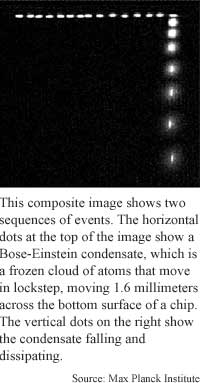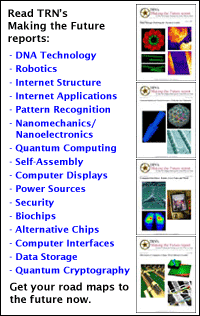
Atom
laser fits on a chip
By
Kimberly Patch,
Technology Research NewsFiguring out how to coax electrons to flow through wires etched in silicon chips has produced many returns. Televisions, computers, cheap electronic toys, and many kinds of sensors all contain silicon chips.
Using computer chips to line up photons into laser beams has also helped bring about technologies as diverse as compact discs and high-speed telecommunications.
An emerging area of research that promises to enable new technologies is figuring out how to control beams of atoms. A group of researchers from the Max Planck Institute in Germany has taken a large step in that direction by demonstrating that it is possible to herd a cloud of atoms around a silicon chip.
Since Massachusetts Institute of Technology physics professor Wolfgang Ketterle and his colleagues made the first atom laser in 1997, scientists have been able to focus beams of atoms in much the same way lasers focus beams of photons. Ketterle and two of his colleagues received the 2001 Nobel Prize in physics last week for discovering the form of matter used in atom lasers.
Today's atom lasers are very bulky, however. Being able to control atoms on a chip makes the technique much more practical.
Controlling atoms on a silicon chip is similar to the miniaturization process that made computer chips commonplace, said Jakob Reichel, a research assistant at the Max Planck Institute for Quantum Optics at the University of Munich. "[It] can be compared to the step from discrete transistors to integrated microelectronics," he said.
It paves the way for miniaturized versions of very accurate measuring devices like atomic clocks and acceleration sensors, and will make it easier to study the nature of atoms; it is also a step toward making practical quantum computers, Reichel said.
The key to corralling atoms on a chip was keeping the gas atoms in a frigid Bose-Einstein condensate contained in close proximity to the much warmer chip. "The main uncertainty was whether the fragile, ultra-cooled quantum state would survive being so close to the surface of the chip, which is at room temperature," said Reichel.
Normally, atoms act independently of each other, but when a gas is cooled to less than one degree above absolute zero it can form a Bose-Einstein condensate, where all the gas atoms have the same properties. Absolute zero is -273 degrees Celsius. One of the strange properties of quantum particles like atoms and photons is that they also act like waves. In a Bose-Einstein condensate, like laser light, the crests and troughs of the particles are in sync.
The researchers preserved the fragile Bose-Einstein condensate by using magnetic fields to hold the cloud of coordinated atoms a fraction of a millimeter above the chip surface. This is in contrast to electrical circuits, where the electrons travel through the wires on a chip.
To coax the rubidium atoms to form a Bose-Einstein condensate the researchers used the standard method of several cycles of evaporation to cool them to less than one degree above absolute zero. The efficiency of their trap also reduced the cooling time of the atoms, allowing them to create a Bose-Einstein condensate in less than one second, which is three to ten times faster than existing methods, according to Reichel. The short condensation time made it more difficult for impurities to destroy the condensate.
The researchers then used electromagnetic fields generated by current flowing within 50-micron wires patterned on the surface of an 18- by 22-millimeter chip to hold the cloud of 3,000 rubidium atoms 100 microns above the surface. A micron is one thousandth of a millimeter.
A group of researchers from Tübingen University in Germany has also demonstrated an atom chip by trapping a Bose-Einstein condensate of 40,000 rubidium atoms on a 25- by 0.1-millimeter chip in a similar manner. That experiment used copper conductors that ranged from 3 to 30 microns wide.
The Max Planck researchers took the technology a second step forward by moving the clouds of cold atoms around the surface of the chip with an oscillating electrical current in the chip's wires to make a sort of magnetic conveyor belt.
"For electrons, there are wires, and for light, we have fibers. A possible equivalent for condensed atoms is our conveyor belt," said Reichel. "Now we can... prepare the condensate at one place on the chip, then move it to another place where it measures something or interacts in some other way, and finally move it to a third place," to extract the information it gained.
The effort is an important development in a push to miniaturize atom optics, which could eventually foster a "whole new technology," said Edward Hinds, a physics professor at the University of Sussex and director of the University's Center for Optical and Atomic Physics. "This experiment is one step in a whole program being driven forward by half a dozen groups in Europe, USA, and Japan... to bring atom optics onto a chip," he said.
The ability to manipulate streams of atoms could lead to practical uses as diverse as those that developed after humans discovered how to manipulate streams of electrons, said Hinds. "Electronics has proved good for making a variety of instruments -- TV, radio, telephone, robots, sensors, computers -- that were not entirely clear when the basic methods were being developed," he said.
The practice of manipulating atoms on a chip "is still very primitive, so we don't really know the best [uses for them], but it is already clear that atom chips will make very good devices for measuring gravity," for example, said Hinds.
The research is also relevant to quantum computing, Hinds said. "It will also become possible to look at how the phase [or wiggling of the atom wave] of the BEC can be manipulated, and how it is affected" by the chip environment, he said. "These are important issues in learning how to design and build quantum computers," he said.
Quantum computers can, in theory, manipulate atoms to do certain computations that are beyond the reach of even the fastest possible classical computer. Quantum computing schemes use quantum particle traits like spin to store the ones and zeros that represent information in computing. Particles like atoms and electrons have one of two types of spin, which can be likened to a top spinning clockwise or counterclockwise. In theory, quantum computers could manipulate the spins of a set of atoms like those in a Bose-Einstein condensate to perform calculations that crack secret codes or search large databases.
In addition, atom chips promise to reveal secrets about the nature of quantum gases, Hinds said. For instance, "a Bose-Einstein concentrate on a chip can be squeezed into a long thin tube, or a very flat pancake, where it's properties are predicted to be very different," he said.
It will take roughly five years for portable, integrated atom interferometers, which are used as ultraprecise measuring instruments, to be made from atom chips, said Reichel.
Reichel's research colleagues were Wolfgang Hänsel, Peter Hommelhoff and Theodor W. Hänsch of the Max Planck Institute and the University of Munich. They published the research in the October 4, 2001 issue of the journal Nature. The research was funded by the Max Planck society, the European Union (EU), and the University of Munich.
Timeline: 5 years, > 10 years
Funding: Government, Private, University
TRN Categories: Quantum Computing
Story Type: News
Related Elements: Technical paper, "Bose-Einstein Condensate on a Microelectronic Chip," Nature, October 4, 2001; Technical paper, "Bose-Einstein Condensate in a Surface Micro Trap," posted on the arXiv physics archive at http://arXiv.org/abs/cond-mat/0109322.
Advertisements:
October 17, 2001
Page One
Atom laser fits on a chip
Email takes brainpower
Teamed computers drive big display
Holograms control data beams
Pressure produces smaller circuits

News:
Research News Roundup
Research Watch blog
Features:
View from the High Ground Q&A
How It Works
RSS Feeds:
News
Ad links:
Buy an ad link
| Advertisements:
|
 |
Ad links: Clear History
Buy an ad link
|
TRN
Newswire and Headline Feeds for Web sites
|
© Copyright Technology Research News, LLC 2000-2006. All rights reserved.